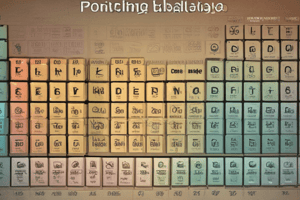Podcast
Questions and Answers
What does the 'B series' in the periodic table refer to?
What does the 'B series' in the periodic table refer to?
- Actinide series
- Lanthanide series
- Alkaline earth metals
- Transition elements (correct)
Which group of elements is known as the halogens?
Which group of elements is known as the halogens?
- Group 2A
- Group 8A
- Group 7A (correct)
- Group 1A
Which elements are part of the lanthanide series?
Which elements are part of the lanthanide series?
- Thorium to lawrencium
- Zirconium to mercury
- Cerium to lutetium (correct)
- Neptunium to roentgenium
Which group of metals are known as the alkali metals?
Which group of metals are known as the alkali metals?
What is the term used for each horizontal row of the periodic table?
What is the term used for each horizontal row of the periodic table?
Study Notes
The B series elements
- The 'B series' in the periodic table is a convention used to designate elements in the transition metal groups.
- These elements are located in groups 3 to 12 on the periodic table, sometimes referred to as "B groups" or "transition metals".
- The B series elements are known for their variable oxidation states, which means they can form ions with different charges.
Halogen Group
- The halogens are a group of non-metallic elements in Group 17 of the periodic table.
- They have 7 electrons in their outer shell, making them highly reactive and prone to form salts.
- Examples of halogens include fluorine (F), chlorine (Cl), bromine (Br), iodine (I), and astatine (At).
Lanthanide Series
- The lanthanides are a series of 15 metallic elements located in the f-block of the periodic table.
- They are also known as the rare-earth elements and are characterized by their similar chemical properties.
- Lanthanides are known for their use in various applications, including lasers, magnets, and electronics.
Alkali Metals
- Alkali metals are a group of highly reactive metallic elements in Group 1 of the periodic table.
- They have one electron in their outer shell, making them readily willing to lose an electron to form positive ions.
- Examples of alkali metals include lithium (Li), sodium (Na), potassium (K), rubidium (Rb), cesium (Cs), and francium (Fr).
Periodic Table Rows
- Each horizontal row in the periodic table is called a period.
- Elements within the same period share the maximum number of electron shells, implying that they have similar atomic and chemical properties.
- The number of periods on the periodic table corresponds to the number of electron shells an atom has.
Studying That Suits You
Use AI to generate personalized quizzes and flashcards to suit your learning preferences.
Description
Test your knowledge on the periodic table and the relationships among elements. Learn about the vertical columns, main group elements, transition elements, alkali metals, and alkaline earth metals.




